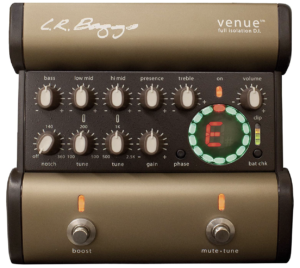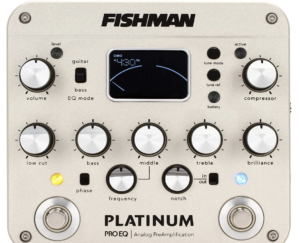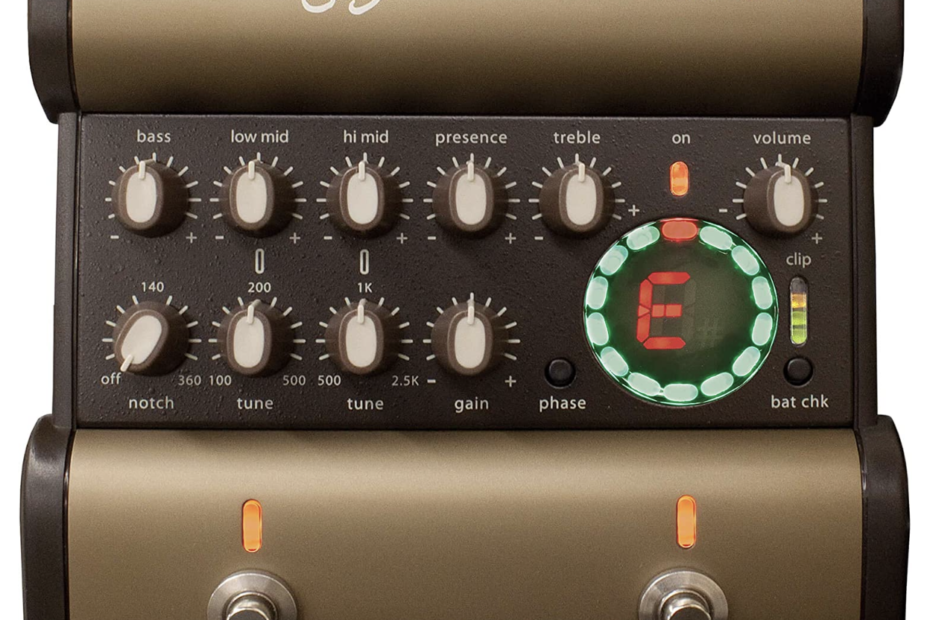When it comes to best pedal for acoustic guitar, the choice depends on the specific needs and preferences of the guitarist. While acoustic guitars generally have a more natural and organic sound, certain pedals can enhance and shape that sound in unique ways.
Here are six popular pedal types that are commonly used with acoustic guitars:
Acoustic Preamp/DI pedal for acoustic guitar
 An acoustic preamp or DI (Direct Injection) pedal is essential for optimizing the acoustic guitar’s signal before it reaches the PA system or recording interface. It typically includes features like EQ controls, gain adjustment, phase inversion, and balanced outputs to ensure a clean and balanced signal transfer.
An acoustic preamp or DI (Direct Injection) pedal is essential for optimizing the acoustic guitar’s signal before it reaches the PA system or recording interface. It typically includes features like EQ controls, gain adjustment, phase inversion, and balanced outputs to ensure a clean and balanced signal transfer.
Here are some examples:
- LR Baggs Venue DI: The LR Baggs Venue DI is a highly regarded acoustic preamp/DI pedal. It features EQ controls, adjustable gain, a built-in tuner, and a boost switch for added volume during solos. It also offers a 3-band EQ and a notch filter to help control feedback.
 Fishman Platinum Pro EQ/DI: The Fishman Platinum Pro EQ/DI is another versatile acoustic preamp/DI pedal. It offers a 5-band EQ, adjustable gain, and a blendable notch filter to control feedback. It also includes a phase switch, a built-in tuner, and a boost function.
Fishman Platinum Pro EQ/DI: The Fishman Platinum Pro EQ/DI is another versatile acoustic preamp/DI pedal. It offers a 5-band EQ, adjustable gain, and a blendable notch filter to control feedback. It also includes a phase switch, a built-in tuner, and a boost function.- Radial Tonebone PZ-Pre Acoustic Preamp: The Radial Tonebone PZ-Pre is a feature-packed preamp/DI pedal designed specifically for acoustic instruments. It provides a 3-band EQ, adjustable gain, effects loop, built-in tuner, and a notch filter. It also features a PZB boost for enhancing low-frequency response on stage.
- Zoom AC-3 Acoustic Creator: The Zoom AC-3 Acoustic Creator combines a preamp/DI with acoustic modeling technology. It offers various acoustic guitar and microphone models, along with built-in effects like reverb and chorus. It also includes EQ controls, a feedback control, and a built-in tuner.
- Boss AD-10 Acoustic Preamp: The Boss AD-10 Acoustic Preamp is a versatile pedal with advanced sound processing features. It includes comprehensive EQ controls, a feedback suppressor, multi-band compressor, and ambiance effects like reverb and delay. It also offers built-in DI functionality and a tuner.
Also Read:
Best compressor guitar pedal for 2023
7 Best looper pedals for guitar
6 Best Delay Pedals for Guitar
Flamma FX100 Guitar Multi-effects Pedal Review
Mooer E7: Polyphonic Guitar Synth Effects Pedal Review
Nux Loop Core Pedal: The Looper To Rule All
Reverb Pedal
 When it comes to acoustic guitar, a reverb pedal can add a beautiful sense of space and depth to your sound. It simulates the natural reverberation that occurs in different acoustic environments, giving your guitar tone a more immersive and atmospheric quality. There are a few things to know about reverb pedals for acoustic guitar:
When it comes to acoustic guitar, a reverb pedal can add a beautiful sense of space and depth to your sound. It simulates the natural reverberation that occurs in different acoustic environments, giving your guitar tone a more immersive and atmospheric quality. There are a few things to know about reverb pedals for acoustic guitar:
So, you know that reverb pedals offer different types of reverberation effects, right? You’ve got hall, room, plate, spring, and shimmer, just to name a few. Each type has its own unique character and ambiance, allowing you to choose the reverb sound that fits your playing style and musical genre.
Now, let’s talk about the controls and parameters. Most reverb pedals let you tweak the reverb level, decay time, pre-delay, and tone. These controls give you the flexibility to adjust the intensity, length, and tonal characteristics of the reverb effect. It’s all about dialing in the perfect amount of reverb to create the desired sound.
One great thing about reverb pedals is their versatility. They’re not just for acoustic guitars – you can use them with ukuleles, mandolins, and other acoustic instruments too. And they work well across various musical genres, whether you’re into folk, country, jazz, or rock. With a reverb pedal, you can experiment with different sounds and textures to add depth and dimension to your acoustic guitar playing.
Now, the goal of a good reverb pedal is to provide a natural and transparent reverb effect that doesn’t alter or color your guitar’s original tone. It should enhance the sound without getting in the way or introducing any unwanted artifacts. Look for reverb pedals that are known for their high-quality algorithms and signal processing to ensure a pristine and authentic reverb sound.
Some reverb pedals offer stereo inputs and outputs, which can take your acoustic guitar sound to another level. Stereo reverb creates a wider and more immersive soundstage, making your guitar tone feel more spacious and enveloping.
When it comes to portability, reverb pedals come in different sizes. If you’re planning to use the pedal for live performances or on the go, you might want to consider a compact and pedalboard-friendly option. These smaller pedals are convenient and can easily fit into your pedalboard setup.
Lastly, some reverb pedals offer additional features like trails (where the reverb naturally decays when the effect is turned off), stereo connectivity, and even MIDI capabilities for advanced control and integration with other gear.
Delay pedal for acoustic guitar
 Delay pedals can be used to add repeats or echoes to your acoustic guitar’s sound. They can create a spacious and ethereal ambiance, as well as provide rhythmic patterns and textures to enhance your playing.
Delay pedals can be used to add repeats or echoes to your acoustic guitar’s sound. They can create a spacious and ethereal ambiance, as well as provide rhythmic patterns and textures to enhance your playing.
Here are a few examples of delay pedals that work well with acoustic guitars:
- Boss DD-8 Digital Delay: The Boss DD-8 is a versatile delay pedal that offers a wide range of delay sounds, from subtle echoes to long, atmospheric repeats. It features multiple delay modes, a built-in tap tempo function, and up to 6.4 seconds of delay time. The DD-8 also has a hold mode for creating looping textures, making it a great option for acoustic guitarists looking to add depth and texture to their sound.
- Strymon Timeline: The Strymon Timeline is a high-end delay pedal known for its exceptional sound quality and extensive range of delay effects. It offers various delay types, including tape, analog, and digital simulations, with precise control over parameters such as delay time, feedback, and modulation. The Timeline also has stereo inputs/outputs and MIDI connectivity, making it a versatile choice for acoustic guitarists who want studio-quality delay effects.
 TC Electronic Flashback 2 Delay: The TC Electronic Flashback 2 is a feature-packed delay pedal that offers a wide range of delay sounds in a compact format. It features TC Electronic’s renowned TonePrint technology, which allows you to load custom delay presets created by professional guitarists. The Flashback 2 also has a tap tempo function, stereo inputs/outputs, and a built-in looper, making it a versatile and user-friendly option for acoustic guitar players.
TC Electronic Flashback 2 Delay: The TC Electronic Flashback 2 is a feature-packed delay pedal that offers a wide range of delay sounds in a compact format. It features TC Electronic’s renowned TonePrint technology, which allows you to load custom delay presets created by professional guitarists. The Flashback 2 also has a tap tempo function, stereo inputs/outputs, and a built-in looper, making it a versatile and user-friendly option for acoustic guitar players.- MXR Carbon Copy Analog Delay: The MXR Carbon Copy is a popular analog delay pedal loved for its warm and vintage-sounding repeats. It features bucket brigade circuitry that provides organic and smooth delay tones. The Carbon Copy offers up to 600ms of delay time and has controls for delay time, mix, and regeneration. Its simplicity and warm analog character make it a great choice for adding subtle and natural-sounding delay to your acoustic guitar.
Chorus
Chorus pedals add a shimmering and swirling effect to your acoustic guitar’s sound. They thicken the tone by duplicating the signal, slightly detuning it, and mixing it with the original signal. This creates a chorus-like effect that can add depth and richness to your sound.
EQ (Equalizer)
An EQ pedal allows you to shape the frequency response of your acoustic guitar. It can be used to boost or cut specific frequencies, helping you to sculpt the tone to your liking and compensate for any inconsistencies in your instrument or the environment.
Compression pedal for acoustic guitar
A compression can be a best pedal for acoustic guitar. It can even out the dynamic range of your acoustic guitar’s signal, providing a more balanced and consistent sound. It helps to control peaks and sustain, ensuring that your playing is smooth and controlled.
It’s important to note that not all pedals are specifically designed for acoustic guitars, but many can still be effectively used with them. It’s recommended to test different pedals and experiment with various combinations to find the ones that best suit your playing style and desired sound.
